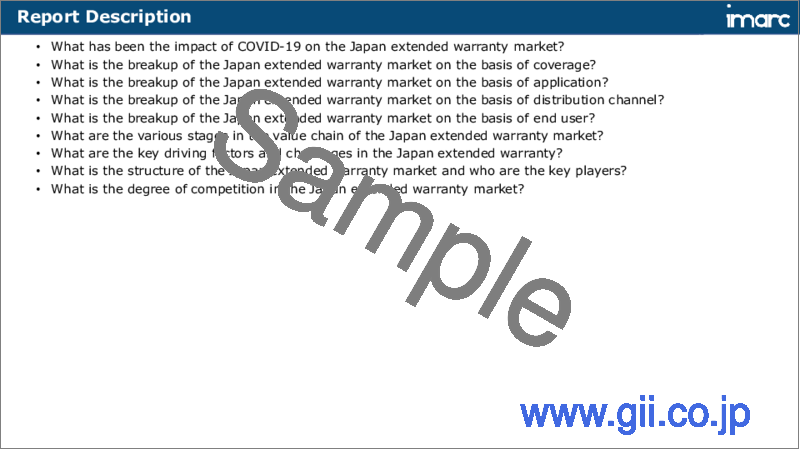|
|
市場調査レポート
商品コード
1746847
日本の延長保証市場レポート:カバレッジ、用途、流通チャネル、エンドユーザー、地域別、2025年~2033年Japan Extended Warranty Market Report by Coverage, Application, Distribution Channel, End User, and Region 2025-2033 |
||||||
カスタマイズ可能
|
|||||||
| 日本の延長保証市場レポート:カバレッジ、用途、流通チャネル、エンドユーザー、地域別、2025年~2033年 |
|
出版日: 2025年06月02日
発行: IMARC
ページ情報: 英文 120 Pages
納期: 5~7営業日
|
全表示
- 概要
- 目次
日本の延長保証市場規模は2024年に86億9,960万米ドルに達しました。今後、IMARC Groupは、2033年には201億1,930万米ドルに達し、2025年から2033年にかけて9.8%の成長率(CAGR)を示すと予測しています。遠隔診断や予知保全など、保証請求のコストを削減し顧客満足度を向上させる技術の進歩が、主に市場を牽引しています。
本レポートで扱う主な質問
- 日本の延長保証市場はこれまでどのように推移し、今後どのように推移するのか?
- COVID-19は日本の延長保証市場にどのような影響を与えたか?
- 日本の延長保証市場のカバレッジ別内訳は?
- 日本の延長保証市場の用途別内訳は?
- 日本の延長保証市場の流通チャネル別内訳は?
- 日本の延長保証市場のエンドユーザー別内訳は?
- 日本の延長保証市場のバリューチェーンにおける様々なステージとは?
- 日本の延長保証の主要な促進要因と課題は何か?
- 日本の延長保証市場の構造と主要プレーヤーは?
- 日本の延長保証市場における競合の程度は?
目次
第1章 序文
第2章 調査範囲と調査手法
- 調査の目的
- ステークホルダー
- データソース
- 市場推定
- 調査手法
第3章 エグゼクティブサマリー
第4章 日本の延長保証市場- イントロダクション
- 概要
- 市場力学
- 業界動向
- 競合情報
第5章 日本の延長保証市場情勢
- 過去および現在の市場動向(2019~2024年)
- 市場予測(2025~2033年)
第6章 日本の延長保証市場- カバレッジ別内訳
- 標準保護プラン
- アクシデント保護プラン
第7章 日本の延長保証市場- 用途別内訳
- 自動車
- 家電
- 家電製品
- モバイルデバイスとPC
- その他
第8章 日本の延長保証市場- 流通チャネル別内訳
- メーカー
- 小売業者
- その他
第9章 日本の延長保証市場- エンドユーザー別内訳
- 個人
- ビジネス
第10章 日本の延長保証市場-競合情勢
- 概要
- 市場構造
- 市場企業のポジショニング
- 主要成功戦略
- 競合ダッシュボード
- 企業評価象限
第11章 主要企業のプロファイル
第12章 日本の延長保証市場- 業界分析
- 促進要因・抑制要因・機会
- ポーターのファイブフォース分析
- バリューチェーン分析
第13章 付録
Japan extended warranty market size reached USD 8,699.6 Million in 2024. Looking forward, IMARC Group expects the market to reach USD 20,119.3 Million by 2033, exhibiting a growth rate (CAGR) of 9.8% during 2025-2033. The increasing advances in technology, such as remote diagnostics and predictive maintenance, which can reduce the cost of warranty claims and improve customer satisfaction, are primarily driving the market.
An extended warranty is a service contract or protection plan that consumers can purchase for their products, typically electronics, appliances, or vehicles, to provide additional coverage beyond the manufacturer's warranty. Unlike the standard warranty that comes with the purchase, an extended warranty offers an extended duration of protection, often for several years, and covers a wider range of potential issues. Extended warranties vary in cost and coverage, but they typically include repairs or replacements for mechanical or electrical failures that may occur after the original warranty expires. Some plans also offer additional benefits such as coverage for accidental damage, routine maintenance, or even loaner equipment while the product is being repaired. While extended warranties can provide peace of mind and financial protection against unexpected repair costs, consumers should carefully evaluate their needs and consider factors like the product's reliability, repair history, and the cost of the warranty itself before deciding to purchase one. It's essential to read the terms and conditions of the extended warranty to understand what is and isn't covered.
Japan Extended Warranty Market Trends:
The extended warranty market in Japan is experiencing robust growth, primarily due to several key drivers. Firstly, the increasing complexity and sophistication of consumer electronics and automobiles have led to a greater demand for extended warranties. As products become more advanced, consumers are increasingly seeking protection against unexpected repair costs. Moreover, the growing awareness of the potential financial benefits of extended warranties has propelled market growth. Consumers now recognize that these warranties offer peace of mind and can save them money in the long run by covering repairs and replacements. Additionally, the increasing lifespan of products has created a need for extended warranties. As people hold onto their gadgets and vehicles for longer periods, they are more inclined to invest in extended coverage to ensure prolonged utility. Furthermore, the rise of e-commerce and online shopping, which offers the convenience of online purchasing with easily comparable options, is expected to drive the extended warranty market in Japan during the forecast period.
Japan Extended Warranty Market Segmentation:
Coverage Insights:
- Standard Protection Plan
- Accidental Protection Plan
Application Insights:
- Automobiles
- Consumer Electronics
- Home Appliances
- Mobile Devices and PCs
- Others
Distribution Channel Insights:
- Manufacturers
- Retailers
- Others
End User Insights:
- Individuals
- Business
Competitive Landscape:
The market research report has also provided a comprehensive analysis of the competitive landscape. Competitive analysis such as market structure, key player positioning, top winning strategies, competitive dashboard, and company evaluation quadrant has been covered in the report. Also, detailed profiles of all major companies have been provided.
Key Questions Answered in This Report:
- How has the Japan extended warranty market performed so far and how will it perform in the coming years?
- What has been the impact of COVID-19 on the Japan extended warranty market?
- What is the breakup of the Japan extended warranty market on the basis of coverage?
- What is the breakup of the Japan extended warranty market on the basis of application?
- What is the breakup of the Japan extended warranty market on the basis of distribution channel?
- What is the breakup of the Japan extended warranty market on the basis of end user?
- What are the various stages in the value chain of the Japan extended warranty market?
- What are the key driving factors and challenges in the Japan extended warranty?
- What is the structure of the Japan extended warranty market and who are the key players?
- What is the degree of competition in the Japan extended warranty market?
Table of Contents
1 Preface
2 Scope and Methodology
- 2.1 Objectives of the Study
- 2.2 Stakeholders
- 2.3 Data Sources
- 2.3.1 Primary Sources
- 2.3.2 Secondary Sources
- 2.4 Market Estimation
- 2.4.1 Bottom-Up Approach
- 2.4.2 Top-Down Approach
- 2.5 Forecasting Methodology
3 Executive Summary
4 Japan Extended Warranty Market - Introduction
- 4.1 Overview
- 4.2 Market Dynamics
- 4.3 Industry Trends
- 4.4 Competitive Intelligence
5 Japan Extended Warranty Market Landscape
- 5.1 Historical and Current Market Trends (2019-2024)
- 5.2 Market Forecast (2025-2033)
6 Japan Extended Warranty Market - Breakup by Coverage
- 6.1 Standard Protection Plan
- 6.1.1 Overview
- 6.1.2 Historical and Current Market Trends (2019-2024)
- 6.1.3 Market Forecast (2025-2033)
- 6.2 Accidental Protection Plan
- 6.2.1 Overview
- 6.2.2 Historical and Current Market Trends (2019-2024)
- 6.2.3 Market Forecast (2025-2033)
7 Japan Extended Warranty Market - Breakup by Application
- 7.1 Automobiles
- 7.1.1 Overview
- 7.1.2 Historical and Current Market Trends (2019-2024)
- 7.1.3 Market Forecast (2025-2033)
- 7.2 Consumer Electronics
- 7.2.1 Overview
- 7.2.2 Historical and Current Market Trends (2019-2024)
- 7.2.3 Market Forecast (2025-2033)
- 7.3 Home Appliances
- 7.3.1 Overview
- 7.3.2 Historical and Current Market Trends (2019-2024)
- 7.3.3 Market Forecast (2025-2033)
- 7.4 Mobile Devices and PCs
- 7.4.1 Overview
- 7.4.2 Historical and Current Market Trends (2019-2024)
- 7.4.3 Market Forecast (2025-2033)
- 7.5 Others
- 7.5.1 Historical and Current Market Trends (2019-2024)
- 7.5.2 Market Forecast (2025-2033)
8 Japan Extended Warranty Market - Breakup by Distribution Channel
- 8.1 Manufacturers
- 8.1.1 Overview
- 8.1.2 Historical and Current Market Trends (2019-2024)
- 8.1.3 Market Forecast (2025-2033)
- 8.2 Retailers
- 8.2.1 Overview
- 8.2.2 Historical and Current Market Trends (2019-2024)
- 8.2.3 Market Forecast (2025-2033)
- 8.3 Others
- 8.3.1 Historical and Current Market Trends (2019-2024)
- 8.3.2 Market Forecast (2025-2033)
9 Japan Extended Warranty Market - Breakup by End User
- 9.1 Individuals
- 9.1.1 Overview
- 9.1.2 Historical and Current Market Trends (2019-2024)
- 9.1.3 Market Forecast (2025-2033)
- 9.2 Business
- 9.2.1 Overview
- 9.2.2 Historical and Current Market Trends (2019-2024)
- 9.2.3 Market Forecast (2025-2033)
10 Japan Extended Warranty Market - Competitive Landscape
- 10.1 Overview
- 10.2 Market Structure
- 10.3 Market Player Positioning
- 10.4 Top Winning Strategies
- 10.5 Competitive Dashboard
- 10.6 Company Evaluation Quadrant
11 Profiles of Key Players
- 11.1 Company A
- 11.1.1 Business Overview
- 11.1.2 Services Offered
- 11.1.3 Business Strategies
- 11.1.4 SWOT Analysis
- 11.1.5 Major News and Events
- 11.2 Company B
- 11.2.1 Business Overview
- 11.2.2 Services Offered
- 11.2.3 Business Strategies
- 11.2.4 SWOT Analysis
- 11.2.5 Major News and Events
- 11.3 Company C
- 11.3.1 Business Overview
- 11.3.2 Services Offered
- 11.3.3 Business Strategies
- 11.3.4 SWOT Analysis
- 11.3.5 Major News and Events
- 11.4 Company D
- 11.4.1 Business Overview
- 11.4.2 Services Offered
- 11.4.3 Business Strategies
- 11.4.4 SWOT Analysis
- 11.4.5 Major News and Events
- 11.5 Company E
- 11.5.1 Business Overview
- 11.5.2 Services Offered
- 11.5.3 Business Strategies
- 11.5.4 SWOT Analysis
- 11.5.5 Major News and Events
12 Japan Extended Warranty Market - Industry Analysis
- 12.1 Drivers, Restraints, and Opportunities
- 12.1.1 Overview
- 12.1.2 Drivers
- 12.1.3 Restraints
- 12.1.4 Opportunities
- 12.2 Porters Five Forces Analysis
- 12.2.1 Overview
- 12.2.2 Bargaining Power of Buyers
- 12.2.3 Bargaining Power of Suppliers
- 12.2.4 Degree of Competition
- 12.2.5 Threat of New Entrants
- 12.2.6 Threat of Substitutes
- 12.3 Value Chain Analysis





